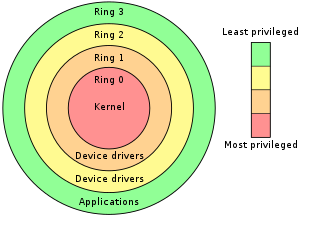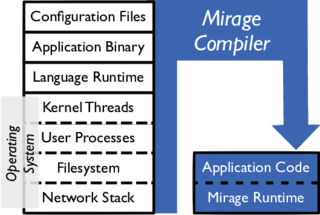Related Research Articles

In the context of an operating system, a device driver is a computer program that operates or controls a particular type of device that is attached to a computer or automaton. A driver provides a software interface to hardware devices, enabling operating systems and other computer programs to access hardware functions without needing to know precise details about the hardware being used.

In computer science, a microkernel is the near-minimum amount of software that can provide the mechanisms needed to implement an operating system (OS). These mechanisms include low-level address space management, thread management, and inter-process communication (IPC).
The trusted computing base (TCB) of a computer system is the set of all hardware, firmware, and/or software components that are critical to its security, in the sense that bugs or vulnerabilities occurring inside the TCB might jeopardize the security properties of the entire system. By contrast, parts of a computer system that lie outside the TCB must not be able to misbehave in a way that would leak any more privileges than are granted to them in accordance to the system's security policy.
Extremely Reliable Operating System (EROS) is an operating system developed starting in 1991 at the University of Pennsylvania, and then Johns Hopkins University, and The EROS Group, LLC. Features include automatic data and process persistence, some preliminary real-time support, and capability-based security. EROS is purely a research operating system, and was never deployed in real world use. As of 2005, development stopped in favor of a successor system, CapROS.
Memory protection is a way to control memory access rights on a computer, and is a part of most modern instruction set architectures and operating systems. The main purpose of memory protection is to prevent a process from accessing memory that has not been allocated to it. This prevents a bug or malware within a process from affecting other processes, or the operating system itself. Protection may encompass all accesses to a specified area of memory, write accesses, or attempts to execute the contents of the area. An attempt to access unauthorized memory results in a hardware fault, e.g., a segmentation fault, storage violation exception, generally causing abnormal termination of the offending process. Memory protection for computer security includes additional techniques such as address space layout randomization and executable-space protection.
Capability-based security is a concept in the design of secure computing systems, one of the existing security models. A capability is a communicable, unforgeable token of authority. It refers to a value that references an object along with an associated set of access rights. A user program on a capability-based operating system must use a capability to access an object. Capability-based security refers to the principle of designing user programs such that they directly share capabilities with each other according to the principle of least privilege, and to the operating system infrastructure necessary to make such transactions efficient and secure. Capability-based security is to be contrasted with an approach that uses traditional UNIX permissions and Access Control Lists.
Multilevel security or multiple levels of security (MLS) is the application of a computer system to process information with incompatible classifications, permit access by users with different security clearances and needs-to-know, and prevent users from obtaining access to information for which they lack authorization.
A hypervisor, also known as a virtual machine monitor (VMM) or virtualizer, is a type of computer software, firmware or hardware that creates and runs virtual machines. A computer on which a hypervisor runs one or more virtual machines is called a host machine, and each virtual machine is called a guest machine. The hypervisor presents the guest operating systems with a virtual operating platform and manages the execution of the guest operating systems. Unlike an emulator, the guest executes most instructions on the native hardware. Multiple instances of a variety of operating systems may share the virtualized hardware resources: for example, Linux, Windows, and macOS instances can all run on a single physical x86 machine. This contrasts with operating-system–level virtualization, where all instances must share a single kernel, though the guest operating systems can differ in user space, such as different Linux distributions with the same kernel.
System Management Mode is an operating mode of x86 central processor units (CPUs) in which all normal execution, including the operating system, is suspended. An alternate software system which usually resides in the computer's firmware, or a hardware-assisted debugger, is then executed with high privileges.

In computer science, hierarchical protection domains, often called protection rings, are mechanisms to protect data and functionality from faults and malicious behavior.
Intel Trusted Execution Technology is a computer hardware technology of which the primary goals are:
The XTS-400 is a multilevel secure computer operating system. It is multiuser and multitasking that uses multilevel scheduling in processing data and information. It works in networked environments and supports Gigabit Ethernet and both IPv4 and IPv6.
In computer science, capability-based addressing is a scheme used by some computers to control access to memory as an efficient implementation of capability-based security. Under a capability-based addressing scheme, pointers are replaced by protected objects which specify both a location in memory, along with access rights which define the set of operations which can be carried out on the memory location. Capabilities can only be created or modified through the use of privileged instructions which may be executed only by either the kernel or some other privileged process authorised to do so. Thus, a kernel can limit application code and other subsystems access to the minimum necessary portions of memory, without the need to use separate address spaces and therefore require a context switch when an access occurs.
Hydra is an early, discontinued, capability-based, object-oriented microkernel designed to support a wide range of possible operating systems to run on it. Hydra was created as part of the C.mmp project at Carnegie Mellon University in 1971.
The separation of mechanism and policy is a design principle in computer science. It states that mechanisms should not dictate the policies according to which decisions are made about which operations to authorize, and which resources to allocate.
In computer science, protection mechanisms are built into a computer architecture to support the enforcement of security policies. A simple definition of a security policy is "to set who may use what information in a computer system".
A separation kernel is a type of security kernel used to simulate a distributed environment. The concept was introduced by John Rushby in a 1981 paper. Rushby proposed the separation kernel as a solution to the difficulties and problems that had arisen in the development and verification of large, complex security kernels that were intended to "provide multilevel secure operation on general-purpose multi-user systems." According to Rushby, "the task of a separation kernel is to create an environment which is indistinguishable from that provided by a physically distributed system: it must appear as if each regime is a separate, isolated machine and that information can only flow from one machine to another along known external communication lines. One of the properties we must prove of a separation kernel, therefore, is that there are no channels for information flow between regimes other than those explicitly provided."

A kernel is a computer program at the core of a computer's operating system that always has complete control over everything in the system. The kernel is also responsible for preventing and mitigating conflicts between different processes. It is the portion of the operating system code that is always resident in memory and facilitates interactions between hardware and software components. A full kernel controls all hardware resources via device drivers, arbitrates conflicts between processes concerning such resources, and optimizes the utilization of common resources e.g. CPU & cache usage, file systems, and network sockets. On most systems, the kernel is one of the first programs loaded on startup. It handles the rest of startup as well as memory, peripherals, and input/output (I/O) requests from software, translating them into data-processing instructions for the central processing unit.
In information security, computer science, and other fields, the principle of least privilege (PoLP), also known as the principle of minimal privilege (PoMP) or the principle of least authority (PoLA), requires that in a particular abstraction layer of a computing environment, every module must be able to access only the information and resources that are necessary for its legitimate purpose.

A unikernel is a type of computer program that is statically linked with the operating system code on which it depends. Unikernels are built with a specialized compiler that identifies the operating system services that a program uses and links it with one or more library operating systems that provide them. Such a program requires no separate operating system and can run instead as the guest of a hypervisor.
References
- Houdek, M. E., Soltis, F. G., and Hoffman, R. L. 1981. IBM System/38 support for capability-based addressing . In Proceedings of the 8th ACM International Symposium on Computer Architecture. ACM/IEEE, pp. 341–348.
- Intel Corporation (2002) The IA-32 Architecture Software Developer’s Manual, Volume 1: Basic Architecture
- Carl E. Landwehr Formal Models for Computer Security Volume 13, Issue 3 (September 1981) pp. 247 – 278
- Swift, Michael M; Brian N. Bershad, Henry M. Levy, Improving the reliability of commodity operating systems , ACM Transactions on Computer Systems (TOCS), v.23 n.1, p. 77-110, February 2005
- Wulf, W.; E. Cohen; W. Corwin; A. Jones; R. Levin; C. Pierson; F. Pollack (June 1974). "HYDRA: the kernel of a multiprocessor operating system". Communications of the ACM. 17 (6): 337–345. doi: 10.1145/355616.364017 . ISSN 0001-0782. S2CID 8011765.